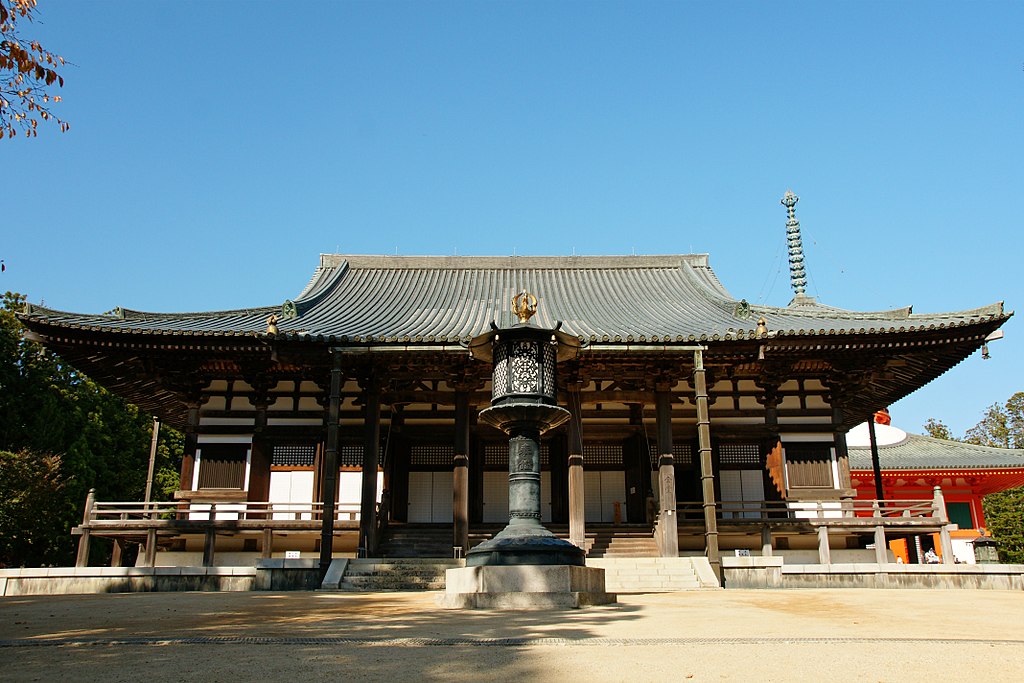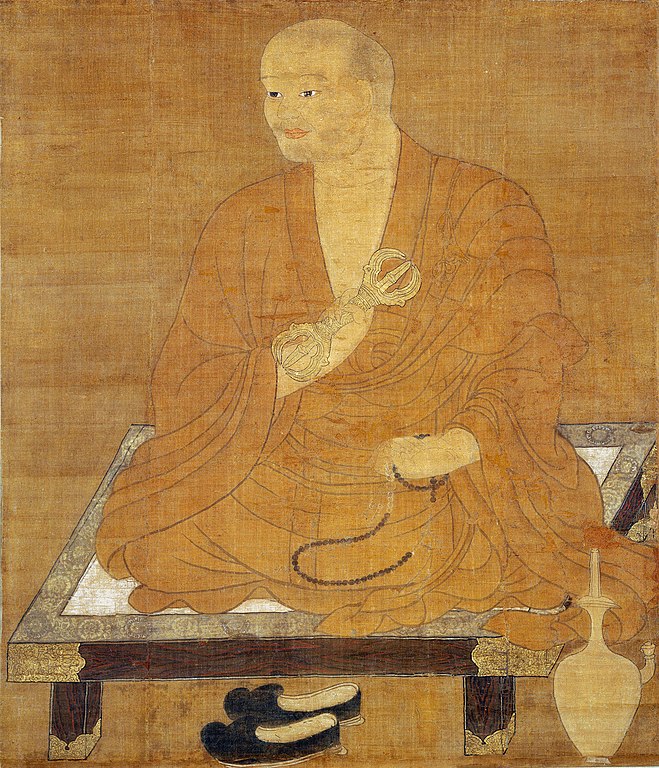
The Shingon school was, like the Tendai school, founded in the Heian period (794-1185), at a time when the imperial court was still wielding power, with the support of the Fujiwara clan. This period saw a dramatic growth of Buddhism, with the foundation of the first two mountain-top temple complexes on Mt Hiei by Saicho, and Mt Koya by Kukai, which are still regarded today as major centres of study and practice, as well as popular pilgrimage sites.
Kukai (774-835) is known in Japan by his posthumous name Kobo Daishi (“The Great Master who Propagated the Dharma”), and revered as a cultural hero, not only the founder of the school of Shingon Buddhism, but the man who brought Buddhism to the Japanese people. Though Buddhism had been introduced to Japan in the 6th century, it had remained, until the middle of the 9th century, the prerogative of the court in Nara. Kukai made it available to ordinary people.
Yoshito Hakeda writes: “Legends about Kukai are still being told all over the country, especially in the western part where he grew up and spent most of his life. In addition to the common belief that, as the inventor of the kana syllabary, he was the father of Japanese culture, he is remembered as the founder of Shingon or Esoteric Buddhism in Japan, the founder of the monastic center on Mt Koya, the originator of the pilgrimage circuit of eighty-eight temples on Shikoku, a builder of lakes, a wandering saint who engaged in severe ascetic practices, and a great calligrapher.”To be precise, Hakeda adds, “Kukai did not actually invent the kana syllabary, but its emergence owed much to his introduction of Sanskrit studies, for the kana system is formed on the basis of the Sanskrit alphabet.”
Kukai’s life can be divided into four periods: a) an early life which ended with his trip to China in 804; b) a meeting in Chang’an with Huiguo, which resulted in his being granted the title of Eighth Patriarch of the Shingon lineage; c) a period of trial as Emperor Kammu supported Saicho’s establishment of the Tendai school on Mt Hiei, and paid little attention to Kukai; d) his eventual rise to eminence after he gained the support of Emperor Saga in 809, promoting Esoteric Buddhism from his Kyoto base at the Takaosanji, then, from 819 onwards, moving back and forth between Kyoto and Mt Koya, several days’ walk away, where he supervised the building of a sophisticated temple complex while deepening his practice amidst splendid mountains and wild forests.
Early Period (774-804)
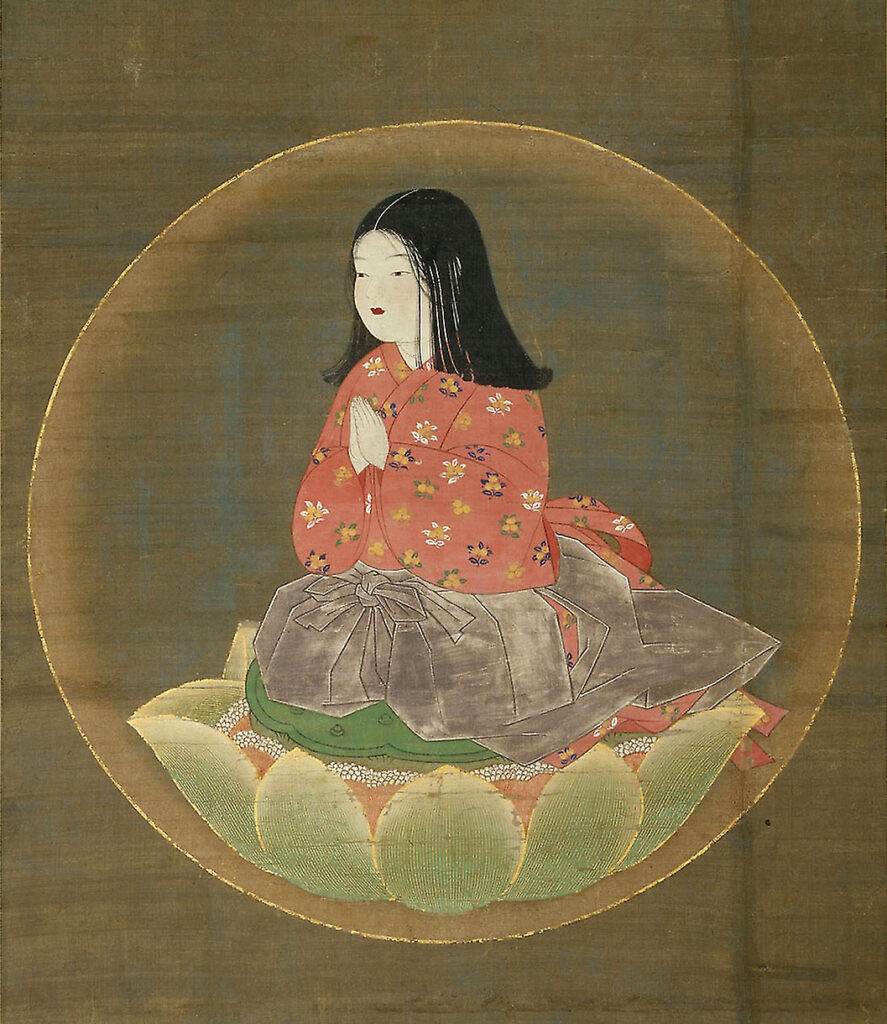
Born into an aristocratic family living in Zentsuji, in the north of Shikaku island, Kukai was expected to follow the standard Confucian curriculum designed to train the sons of such families to become officials in the government. But, Hakeda writes, “no sooner had the eighteen year old Kukai entered the college [in Nara] than he gave up his studies … engaged in a period of ascetic practice, and finally became a novice at twenty.” The Sango shiki (Indications of the Goals of the Three Teachings), a book Kukai wrote when he was twenty-four, explains why. In it, Kukai describes Confucianism as “less a religion than an ethico-political teaching” while “Taoism represented a way to lead a life of escape, or a means to prolong one’s life span.” Hakeda says that at the time “Taoism seems to have been despised and its study and practice discouraged.” As for Shinto, which “involved shamanistic practice,” it “was the binding spiritual force among Japan’s clan-centered communities.“ What Kukai was looking for was a path of “individual salvation,” beyond the transiency he saw in the pursuits of fame and power at the Heian court. In Nara, he joined a group called the Natural Wisdom school which advocated meditation accompanied by recitation of the mantra of Akasagarbha, also known as the Morning Star mantra. He left Nara to go to the Muroto Cape in the south of Shikoku island, and lead the life of a wandering ascetic, begging for food, sitting in a cave to recite the mantra one million times, though he also made trips back to Nara to study texts in its temple libraries. It is said that, during this early period, Kukai read “more than ninety books” including all the major Mahayana sutras, as well as the Zhuangzi and the Daodejing. This pattern of alternating between seclusion and participation in the world is one Kukai kept throughout his life.
Hakeda says that there is no account of Kukai’s life “from the age of twenty-four, when he wrote the Sango shiki to the age of thirty-one, when he set out for China. His biographers have filled the gap with stories of miracles performed by him in various places …”
As for his reasons for going to China, Hakeda notes that “all accounts agree that Kukai went to China in order to answer his questions on the Mahavairocana Sutra … It was the basic text of Esoteric Buddhism representing the most recent phase of seventh-century Indian Buddhism. The amazing fact is that a sutra still relatively new in India and in China should already have been available in Japan. A reliable early document records that a copy of this sutra was made in Japan in 736. It had been translated from Sanskrit into Chinese by an Indian master of Esoteric Buddhism, Subhakarasimha (637-735), in 726. Therefore, it was only ten years later that a copy was made in Japan … Kukai must have been well aware that Esoteric Buddhism was flourishing in Ch’ang-an, the T’ang capital. Before his departure, Kukai intended to stay for twenty years.”
So, in 804, Kukai embarked on Ship One of a fleet of four ships. Saicho (who founded the Tendai School two years later) was on Ship Two … The day after leaving, the ships encountered a storm. Ship Four was lost, with only one survivor. Ship Three returned to Japan. Ship One and Two drifted and ended up at different ports. So it is unlikely that Kukai and Saicho met during this trip! To make matters even worse, Kukai’s ship was refused entry into the port, and Kukai in the end arrived in Chang’an six months after he had left Japan.
Esoteric studies and practice with Huiguo in China (804-806)
When Kukai reached Chang’an, the Tang capital was, along with Baghdad, one of the most cosmopolitan centres of learning in the entire world. Chinese civilisation was at its peak, and foreigners were allowed to pass the civil examinations to obtain posts in the Chinese government. Indian cultural influence was visible. There were sixty four Buddhist temples for monks and twenty seven for nuns, as well as a Nestorian Christian church, a Zoroastrian temple, and an increasing number of Muslims. Esoteric Buddhism had recently been imported from India, and was especially fashionable in court circles. It was where the Mahavairocana Sutra had been translated from Sanskrit.
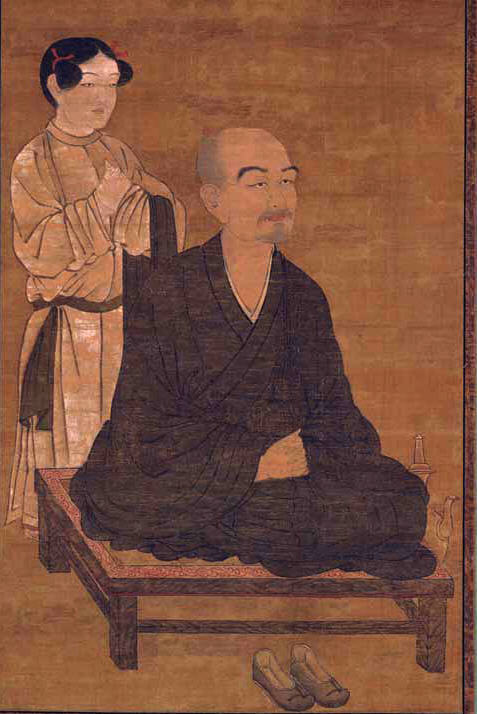
Kukai described Huiguo’s dramatic greeting when he arrived in the company of monks from his temple: “I knew that you would come! I have waited for such a long time. What pleasure it gives me to look upon you today at last! My life is drawing to an end, and until you came there was no one to whom I could transmit the teachings. Go without delay to the altar of abhiseka with incense and a flower.”
Hakeda explains that Huiguo (746-805) had inherited the Dharma of the Esoteric tradition from Amoghavajra (705-774) whose Chinese name was Pu-k’ung. The esoteric school itself had been transmitted to China in 716 when the Chinese emperor invited Subhakarasimha, who brought with him the Mahavairocana Sutra, and translated it into Chinese with the help of Yi Xing (I-hsing). Then, in 720, Vajrabodhi, another reputed master of Esoteric Buddhism, came with more esoteric texts. Amoghavajra/Pu-k’ung became Vajrabodhi’s chosen disciple. Pu-k’ung is regarded as one of the greatest translators of Buddhist texts. Huiguo, under whom Kukai studied, was the legitimate successor of Pu-k’ung.
“The dying Hui-kuo summoned up his last energy to guide Kukai … Within three months after his first meeting with Hui-kuo, Kukai was permitted the final abhiseka and ordained master of Esoteric Buddhism, thus becoming the eighth patriarch at the age of thirty-two.” Huiguo died before the end of 805, and Kukai decided to return to Japan. In addition to obtaining the esoteric lineage, he had learned Sanskrit, calligraphy, poetry, and was carrying voluminous sutras, mandalas, and ritual implements.
Period of Trial upon return to Japan (806-809)
Back in Japan, Kukai sent the emperor a “Memorial Presenting a List of Newly Important Sutras and Other Items” as “state support for a new school of Buddhism was mandatory.” The court did not reply to the Memorial until three years later. The Emperor Kammu, who had authorised Kukai’s journey to China had died, and the new Emperor Heizei was not interested in Buddhism. In addition, Saicho, who had returned from China a year before Kukai “was active as the great authority on Esoteric Buddhism.” In fact, “Esoteric Buddhism had been recognized officially as an integral part of the Tendai sect. It is no wonder then that the court took no immediate action when Kukai presented his Memorial.”
Everything changed when “in the latter half of 809 Kukai received an order from the court to reside at the Takaosanji in the suburbs of Kyoto.” Emperor Heizei had retired because of ill health, and Emperor Saga, then twenty-four, had succeeded him. The Takaosanji temple was the headquarters of Kukai’s activities from 809 until 823 when he moved to the Toji, also in Kyoto. “Emperor Saga turned out to be the promoter of Kukai just as the Emperor Kammu had been of Saicho.”
Rise to Eminence: Takaosanji, Todaiji, Toji, and Koyasan
The Takaosanji, which was later renamed the Jingoji, is the temple where Saicho had resided, even before his trip to China, when Emperor Kammu saw him as a promising young monk. And Saicho had initiated senior monks of Nara Buddhist sects into Esoteric Buddhism there. Kukai and Saicho had begun a correspondence. Their friendship continued for many years after Kukai took up residence in Takaosanji with Kukai lending books he had brought back from China to Saicho, and even holding abhiseka ceremonies for him and his senior disciples. Kukai, however, refused Saicho’s request “to perform for him the highest abhiseka, the initiation as a master of Esoteric Buddhism.” Kukai said that “three years’ study would be necessary in order to qualify.”

Hakeda takes the year 810 as the year when “Kukai emerged as a public figure.” That year, Kukai was also appointed as administrative head of the Todaiji in Nara. The Todaiji was the central temple in Nara, and the most imposing institution in Japan at the time. “Kukai’s later success in superimposing his own Esotericism on Nara Buddhism had its inception in this appointment.”
Though he was able to transform the Takaosanji into the centre of Esoteric Buddhism in Japan, Kukai felt that “he required a site free from the encumbrances of custom and tradition and isolated from the political and social influences of the capital. The Takaosanji was too close to the capital and too small in area to allow the realization of his vision.” In 816, he “asked the Emperor Saga to grant him Mt Koya.”
One of the best-known legends about the foundation of Koyasan tells us how, just before leaving China, Kukai stood on the shore, and threw a three-pronged vajra towards Japan, saying that he would build his temple where the vajra fell. And it is said in the story that the vajra had been found hanging in a three-needled pine tree on Mt Koya. None of this was part of Kukai’s request to Emperor Saga. Instead, Kukai argued that “according to the meditation sutras, meditation should be practiced preferably on a flat area deep in the mountains.” Mt Koya was such a place, and Kukai stated: “I should like to clear the wilderness in order to build a monastery there for the practice of meditation, for the benefit of the nation and of those who desire to discipline themselves.” Building temples on the top of mountains was a new thing at the time, with Mt Hiei and Mt Koya being the two first such temples.
The emperor granted Kukai’s request two months later. A few disciples were immediately sent to “clear the wilderness,” and two years later Kukai was able to officiate at the formal consecration of Mt Koya. “The mountain had been granted personally to Kukai and was henceforth free from all state control.” This meant that Kukai could “realize his vision” without interference. Hakeda describes Kukai’s vision as follows: “Kukai saw Mt Koya as the Matrix Realm, whose symbol is a lotus flower: the eight peaks surrounding the central plateau were the eight petals of the lotus … Mt Koya consists of two circles, the circle of the Diamond Realm within the circle of the Matrix Realm. Within the Diamond Realm … Kukai laid out the Grand Pagoda … Seated in the center of the pagoda is the ultimate Reality, the Mahavairocana of the Diamond Realm … The entire mountain with the central pagoda symbolizes the nonduality of both Realms, which is, according to Kukai, the order of the World of Dharma.”
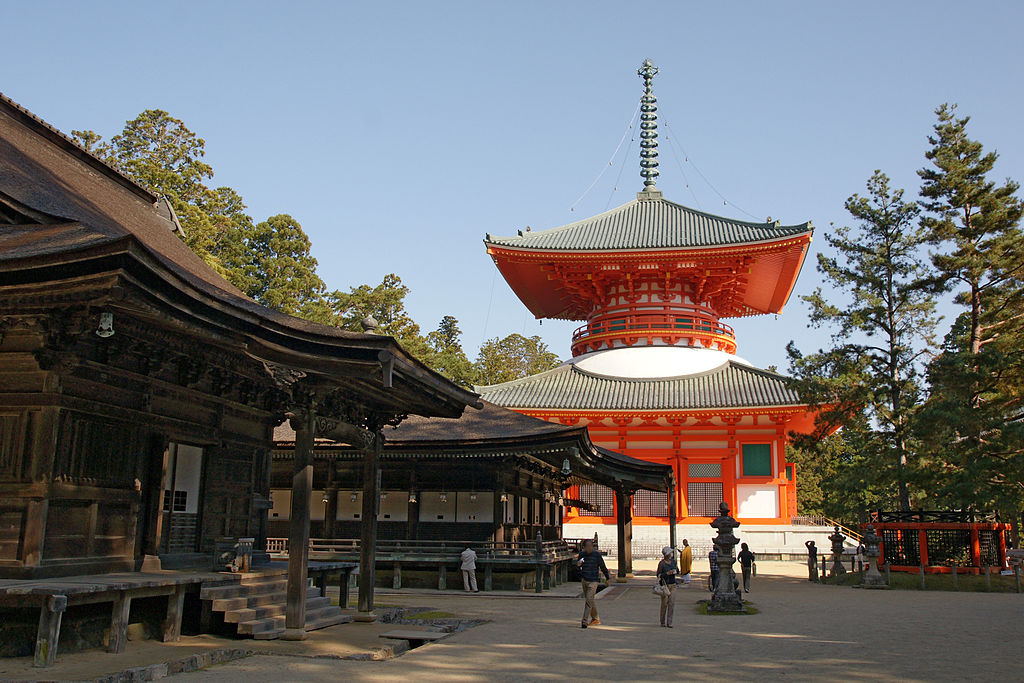
Freedom from state control also meant that “financial difficulties plagued the work up to the very end of Kukai’s life” and Kukai “did not see all his ideas transformed into buildings.” He did not even see the completion of the Grand Pagoda. Because he had shown himself to be such a good administrator, imperial orders kept coming asking Kukai to return to Kyoto. For a time he was asked to act as an adviser to the secretary of state. In 821 he was appointed to direct the reconstruction of a reservoir (Manno no ike) for irrigation as the director in charge of the work had failed. Though he was able to write a number of works when on Mt Koya, Kukai could not spend as much time there as he would have liked.
Then, in 823, Emperor Saga presented him with another temple in Kyoto, the Toji. Kukai moved to the Toji, leaving the Takaosanji in the hands of disciples. The Toji (Eastern Temple) had been built by Emperor Kammu together with the Saiji (Western Temple), when the emperor had moved the capital from Nara to Kyoto. The Toji, however, had remained unfinished, and Kukai was entrusted with its completion. Kukai was also free to turn it into the Esoteric Buddhist centre of Kyoto. Hakeda describes Kukai’s entry into the Toji as “the final step toward the independence of Shingon Buddhism.” He also describes “the ten years between 823 and Kukai’s retirement to Mt Koya in 832” as “the most colorful period” of his life. Saicho had died in 822, and his disciples were eager to adopt esoteric practices. Though Koyasan was still under construction, Kukai could teach at both the Todaiji in Nara, and the Toji in Kyoto. One may wonder how he found the time to also found the “School of Arts and Sciences,” a private school open to all regardless of social status or economic means. It was the first such school in Japan, but, sadly, it was closed ten years after his death.
In 831, Kukai fell seriously ill, and had to retire from his official duties. He remained on Mt Koya until his death in 835. It is said that, as his last days approached, Kukai sat absorbed in meditation and refused food, and that he, in fact, had not died: he had “merely entered into eternal samadhi” and was “still quite alive on Mt Koya as a savior to all suffering people.” Hakeda does, however, write that “in accordance with his will, Kukai, clad in his robes, was interred on the Eastern Peak. He was sixty-two years of age.”
Source: Yoshito S. Hakeda – Kukai: Major Works
